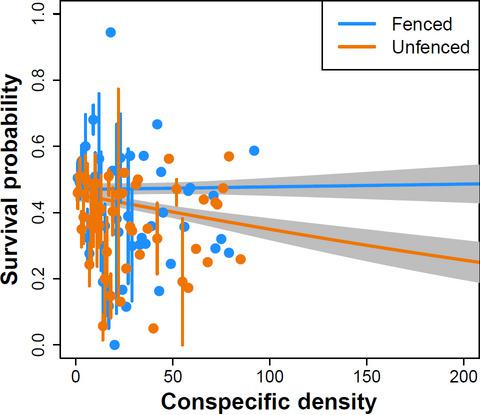Our official English website, www.x-mol.net, welcomes your
feedback! (Note: you will need to create a separate account there.)
Large mammalian herbivores contribute to conspecific negative density dependence in a temperate forest
Journal of Ecology ( IF 5.3 ) Pub Date : 2020-11-01 , DOI: 10.1111/1365-2745.13545 Stephen J. Murphy 1, 2, 3 , Liza S. Comita 2, 4
中文翻译:

大型哺乳动物食草动物在温带森林中造成特定的负密度依赖性
更新日期:2020-11-01
Journal of Ecology ( IF 5.3 ) Pub Date : 2020-11-01 , DOI: 10.1111/1365-2745.13545 Stephen J. Murphy 1, 2, 3 , Liza S. Comita 2, 4
Affiliation

|
- The Janzen–Connell Hypothesis (JCH) predicts that density‐responsive and host‐specific natural enemies limit the population sizes of abundant species. Importantly, these interactions help to maintain local community diversity through time. While ample evidence exists for the demographic predictions of the JCH, it remains unclear which natural enemies drive these dynamics across different plant communities.
- While large mammalian herbivores are often assumed to lack the specialized diet needed to drive Janzen–Connell effects, they do show a degree of host‐preference that could drive density‐dependent plant demography. However, the potential role of large mammalian herbivores in Janzen–Connell interactions has only rarely been investigated.
- Using 204 seedling transects (1 m × 10 m) at 51 sites across a 900‐ha forested reserve in southwestern Pennsylvania (USA), we examined the role that large mammals play in driving conspecific negative density dependence (CNDD) in temperate tree seedlings. Individual fences were erected around half of the transects (n = 102) to exclude large mammals, and were paired with adjacent unfenced transects. Within transects, a total of ~15,000 individual seedlings were monitored over three growing seasons.
- Demographic neighbourhood models were constructed to examine the influence of neighbourhood composition and density on seedling survival and growth. An interaction term between conspecific neighbour density and fencing treatment was included to test the hypothesis that large herbivores cause CNDD.
- We found that seedling survival was influenced by both conspecific neighbour density and fencing. CNDD was strongest when large mammals were allowed access to seedlings, and these results were driven by two abundant taxa (Prunus serotina and Fraxinus spp). Despite evidence that large mammals mediate CNDD, we found no effect of fencing on rarified species richness or evenness in seedling transects during the study.
- Synthesis. Understanding the specific natural enemies driving conspecific negative density dependence remains vital for understanding the maintenance of forest diversity across the globe. Our results indicate that large mammalian herbivores are capable of driving CNDD in temperate tree species. These results suggest that large mammals may be an important and generally overlooked agent contributing to Janzen–Connell interactions in forest communities. We expect that further research examining large mammals in other systems will be important in the future.
中文翻译:

大型哺乳动物食草动物在温带森林中造成特定的负密度依赖性
- Janzen-Connell假说(JCH)预测,密度敏感和寄主特定的天敌会限制丰富物种的种群规模。重要的是,这些互动有助于长期维持当地社区的多样性。尽管有足够的证据表明JCH的人口统计学预测,但尚不清楚哪些天敌在不同植物群落中驱动这些动态。
- 虽然通常认为大型哺乳动物食草动物缺乏驱动Janzen-Connell效应所需的专门饮食,但它们确实显示出一定程度的寄主偏好,可以驱动依赖密度的植物人口统计学。但是,很少研究大型哺乳动物食草动物在Janzen-Connell相互作用中的潜在作用。
- 我们在美国宾夕法尼亚州西南部900公顷森林保护区的51个地点使用204个幼苗样带(1 m×10 m),我们研究了大型哺乳动物在温带树种幼苗中驱动特定的负密度依赖性(CNDD)的作用。在半个样带(n = 102)周围竖立了单独的栅栏,以排除大型哺乳动物,并与相邻的未围栏样带配对。在样带内,在三个生长季节中总共监测了约15,000个单独的幼苗。
- 构建了人口统计学邻域模型,以检验邻域组成和密度对幼苗存活和生长的影响。包括同种邻居密度和围栏处理之间的相互作用项,以检验大草食动物引起CNDD的假说。
- 我们发现,幼苗存活受到同种邻居密度和围栏的影响。当允许大型哺乳动物进入幼苗时,CNDD最强,而这些结果是由两个丰富的类群(李子和水曲柳)驱动的。尽管有证据表明大型哺乳动物会介导CNDD,但在研究过程中,我们并未发现围栏对幼苗样带中稀有物种的丰富度或均匀度没有影响。
- 综合。理解导致特定负密度依赖的特定天敌对于理解全球森林多样性的维持仍然至关重要。我们的结果表明,大型哺乳动物食草动物能够在温带树种中驱动CNDD。这些结果表明,大型哺乳动物可能是造成森林群落中Janzen-Connell相互作用的重要且通常被忽视的媒介。我们希望对其他系统中的大型哺乳动物进行进一步的研究在将来将是重要的。











































 京公网安备 11010802027423号
京公网安备 11010802027423号